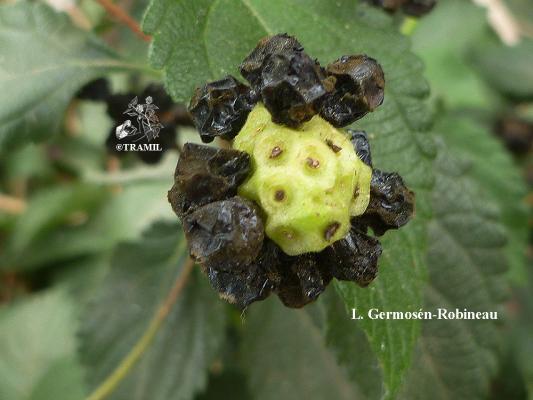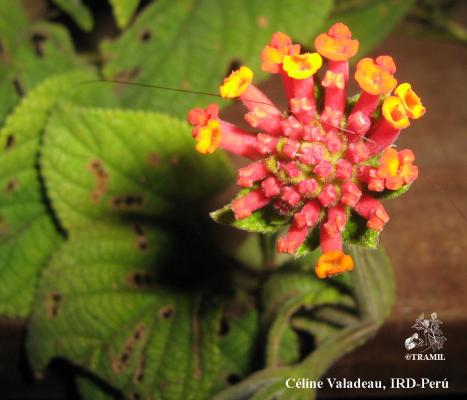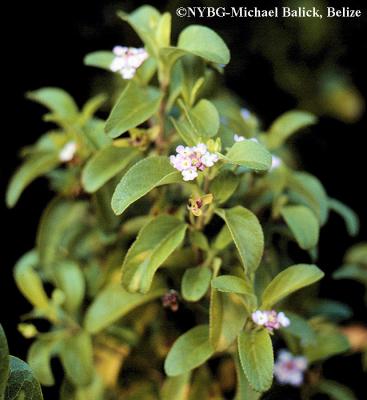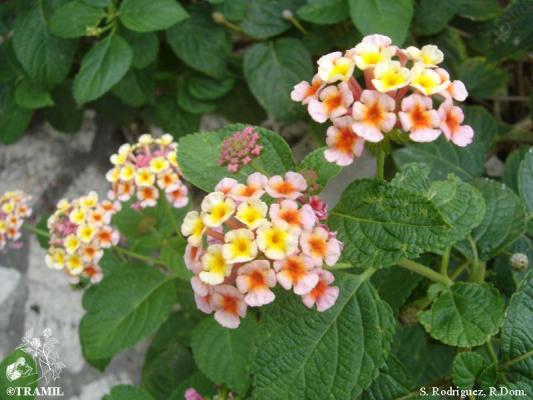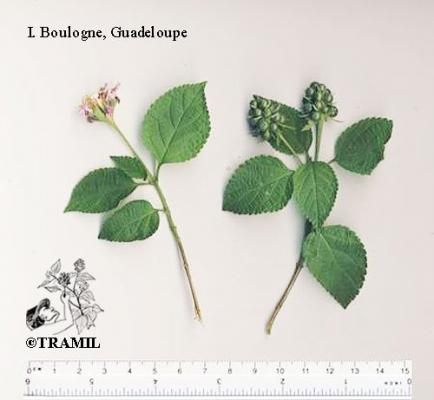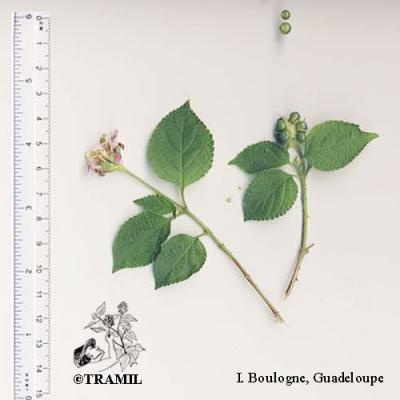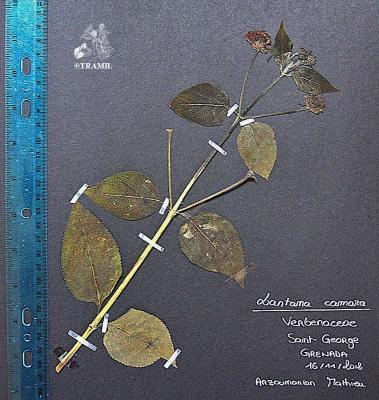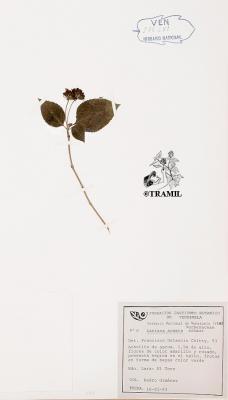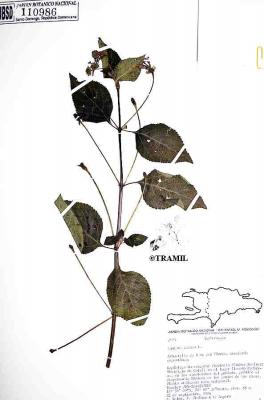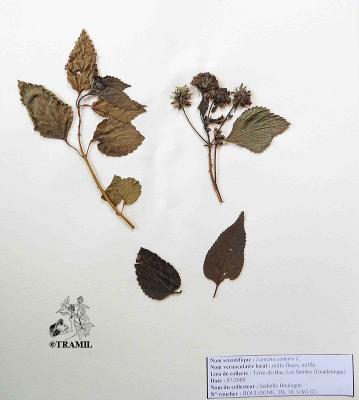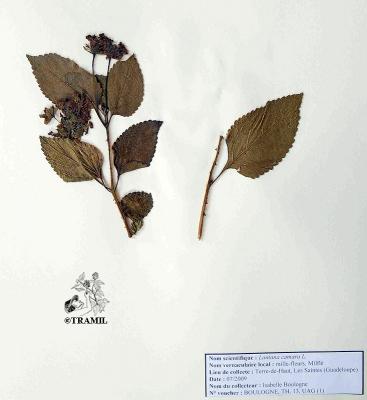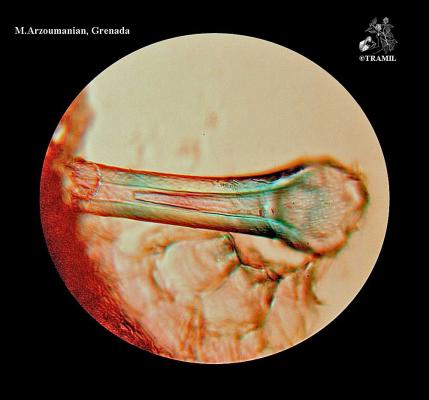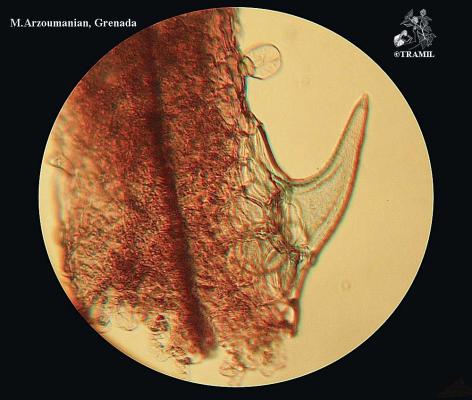Lantana camara
Vernacular names
(In territories with significant traditional TRAMIL use)
Venezuela:
- cariaquillo
- cariaquito
Trinidad and Tobago:
- graterwood
- guanatel
- kayakeet
Dominica:
- mabizou
- red sage
Guatemala:
- siete negritos
Botanical description
Shrub erect or scrambling, aromatic, 1-6 m high, square stems hairy, sometimes prickly. Leaves simple, opposite, occasionally in whorls of three, ovate, margins crenate-serrate; inflorescence a capitate spike; flower tube 6-9 mm and limb 5-7 mm across, ranging from red, orange or yellow; fruit a drupe, ca. 4 mm diameter, ripens dark purple.
Voucher(s)
Girón,197,CFEH
Gimenez,275675,VEN
Delaigue,16,NHTT
Pharmacopoeia
Ed.2References
1 CHARLES C, 1988 TRAMIL survey. Movement for Cultural Awareness MCA, Roseau, Dominica.
2 GIRON L, 1988 Encuesta TRAMIL (Costa atlántica). Centro Mesoamericano de Tecnología CEMAT, Guatemala, Guatemala.
3 DELENS M, 1990 Encuesta TRAMIL en Barlovento, Edo. Miranda de Venezuela. Centro al Servicio de la Acción Popular CESAP, Caracas, Venezuela.
4 SUNDARARAMAIAH T, BAI VV, 1973 Chemical examination of Lantana camara. J Indian Chem Soc 50(9):620.
5 HART N, LAMBERTON J, SIOUMIS A, SUARES H, 1976 New triterpenes of Lantana camara H. A comparative study of the constituents of several taxa. Aust J Chem 29:655-671.
6 TAOUBI K, FAUVEL M, GLEYE J, MOULIS C, FOURASTE I, 1997 Phenylpropanoid glycosides from Lantana camara and Lippia multiflora. Planta Med 63(12):192-193.
7 PAN WD, MAI LT, LI YJ, XU XL, YU DQ, 1993 Studies on the chemical constituents of the leaves of Lantana camara. Yao Xue Xue Bao 28(1):35-39.
8 VERMA D, SINGH S, TRIPATHI V, 1997 A rare antibacterial flavone glucoside from Lantana camara. Indian Drugs 34(1):32-35.
9 WOLLENWEBER E, DORR M, MUNIAPPAN R, SIEMS K, 1997 Flavonoid aglycones and triterpenoids from the leaf exudate of Lantana camara and Lantana montevidensis. Biochem Syst Ecol 25(3):269-270.
10 AHMED Z, EL-MOGHAZY SHOAIB A, WASSEL G, EL-SAYYAD S, 1972 Phytochemical study of Lantana camara. I. Planta Med 21(3):282-288.
11 DUKE JA, ATCHLEY AA, 1986 Handbook of proximate analysis tables of higher plants. Boca Raton, USA: CRC Press. p280.
12 SOLIS PN, RODRIGUEZ N, ESPINOSA A, GUPTA MP, 2004 Estudio antimicrobiano de algunas plantas TRAMIL con usos en Martinica. Informe TRAMIL. Centro de Investigaciones Farmacognósticas de la Flora Panameña CIFLORPAN, Facultad de Farmacia, Universidad de Panamá, Panamá, Panamá.
13 OCCHIUTO F, CIRCOSTA C, COSTA DE PASQUALE R, 1989 Studies on some medicinal plants on Senegal: effects on isolated guinea pig ileum. J Ethnopharmacol 26(2):205-210.
14 CACERES A, FIGUEROA L, TARACENA A, SAMAYOA B, 1993 Plants used in Guatemala for the treatment of respiratory diseases. 2: Evaluation of activity of 16 plants against gram + bacteria. J Ethnopharmacol 39(1):77-82.
15 WANJARI D, 1983 Antihaemorrhagic activity of Lantana camara. Nagarjun 27(2):40-41.
16 AYENSU E, 1982 Medicinal plants of the West Indies. Algonac, USA: Reference Publications Inc.
17 DUKE JA, 1988 Handbook of medicinal herbs. Boca Raton, USA: CRC Press.
18 AKHTER MH, MATHUR M, BHIDE NK, 1990 Skin and liver toxicity in experimental Lantana camara poisoning in albino rats. Indian J Physiol Pharmacol 34(1):13-16.
19 SHARMA VK, KAUR S, 1987 Contact dermatitis due to plants in Chandigarh. Indian J Dermatol Venereol Leprol 53(1):26-30.
20 SHARMA OP, DAWRA RK, MAKKAR HP, 1989 Toxicity of isolated lantana (Lantana camara L.) constituents to male and female guinea pigs. Vet Hum Toxicol 31(1):10-13.
21 FOURIE N, VAN DER LUGT JJ, NEWSHOLME SJ, NEL PW, 1990 Acute Lantana camara toxicity in cattle. J South African Vet Assoc 58(4):173-178.
22 NAOUAR-LABOUP M, 1984 Connaissance sur des Verbénacées: Lantana camara L., espèce hépatotoxique. Constituants chimiques du genre Clerodendron. Doctorat d'Etat n°98, mention pharmacie. Université de Toulouse, France.
23 PASS MA, STEWART C, 1984 Administration of activated charcoal for the treatment of Lantana poisoning of sheep and cattle. J Appl Toxicol 4(5):267-269.
24 DELAIGUE J, 2005 TRAMIL survey. UAG & PRDI, Tobago House of Assembly, Scarborough, Tobago.
Warnings
According to published and other information:
Use of aerial parts for fever, flu, pneumonia and skin diseases is classified as tOxic (TOX).
Given the toxicity of the aerial parts of this plant, its oral and topical uses are discouraged, regardless of how recognized its alleged therapeutic properties may be.
In the event of poisoning from ingestion, seek medical attention.







